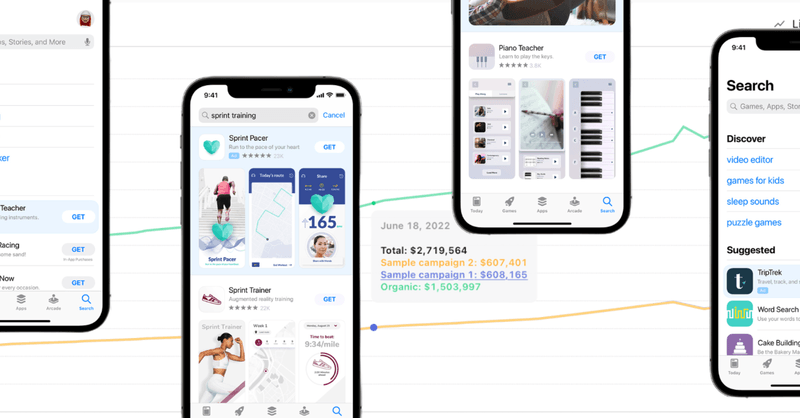How do I measure Apple Search Ads campaigns?
Tracking, charting, and analyzing your ASA campaigns

Apple Search Ads (ASA) allows you to promote your app through sponsored search results. There is a lot to learn about Apple Search Ads, but, simply put, you can target users searching for specific terms on the App Store. If you have an app built for runners, you can use ASA to show a sponsored result for users searching “running” on the App Store. As far as advertising goes, this is about as precise as you can get for targeting users at the moment of intent.
Users can install apps directly from these ads, and you can receive information from Apple about which ad the install came from. This is where iAd and AdServices come into play. These are frameworks from Apple used within an app to get Apple Search Ad attribution details. This allows you to know when an app was installed from an ad, including detailed information like which ad, keyword, and campaign drove the conversion.
Getting campaign attribution data is key to improving your understanding of which campaigns are performing best, how much it costs to acquire users, how much revenue those users contribute, and more. Given the importance of this advertising channel, tracking your ASA attribution data is key to driving profitable growth for your mobile app.
How to Track and Measure Apple Search Ads
There are different kinds of data that you can track and measure from Apple Search Ads. You might be looking for aggregated data to determine which campaigns are performing best. These metrics would be things like impressions, tap-through rate (TTR), conversion rate (CR) cost per tap (CPT), or cost per acquisition (CPA). This aggregated data could be split by app, campaign, country, or keyword. Knowing this information can help determine which ad campaigns to keep running, which to turn off, and which to scale.
However, this aggregated data is not the only thing to look at. The in-app frameworks, iAd and AdServices, can be used to get attribution data from individual app installs. This attribution data contains information like which campaign, ad group, and keyword the user clicked. This can determine the total lifetime value and product usage of customers acquired through specific campaigns, ad groups, and keywords.
What reporting does Apple provide?
Apple provides downloadable reports of aggregated data. The type, amount, and customizability of these reports differ depending on which type of Apple Search Ads you use: Basic or Advanced. ASA Basic users can only download a single report on their campaign data, while Advanced has more robust options.
With Advanced, you have full control of customizing your campaigns (which keywords, countries etc). Basic is geared for smaller apps, and users get almost no control over the campaign. There is only a toggle to enable, pause or disable ads for an app. A Basic user is also limited to $10,000 per month per app, and ads run on an automated cost-per-install (CPI) model.
Since Advanced users have full control of campaigns, they get access to a “Custom Reports” tool for campaign data. There are built-in report templates for keywords, search terms, weekly search term impression share, and more, but the developer can also choose to build reports manually. They can choose from various dimensions and metrics as well as filtering and how often to generate the reports.
Apple’s Reporting Tools Aren’t Enough for Optimization
While Apple’s attribution frameworks collect highly valuable data on your ASA campaigns, how they share this data back via reporting doesn’t give the level of insight that you need to make decisions about the long-term effectiveness of your campaigns.
A major gap in Apple’s reporting is that developers can not track cohorts of customers over time to understand the lifetime value and product usage by users acquired from a certain campaign, keyword, or ad group. Data is exported at a campaign level and doesn’t tie reporting metrics back to specific users. It does allow developers to connect users acquired from a given campaign to their future in-app behaviors – like feature usage, trials, upgrades, and churn.
Apple’s reporting tools also lack visualization. It only allows you to build table format excel spreadsheets for export. This results in manual work to digest the information, track, analyze, and pull insights over time. Not to mention, Basic ASA users, namely smaller apps, get access to minimal data via these report exports.
An example of an Advanced Report Output
An example of a Basic Report Output

How RevenueCat Provides the ASA Insights You Need
RevenueCat is an app monetization platform that makes it easy for developers to implement in-app purchases, manage data, and grow revenue across iOS, Android, and the web. RevenueCat provides a backend and wrapper around Apple’s StoreKit and Google Play Billing to handle the implementation and maintenance of in-app purchases and act as a cross-platform source of truth for your data. And that includes ASA data.
RevenueCat’s Apple Search Ads integration supports the latest AdServices framework. Using this integration, you can view AdServices attribution data within RevenueCat Charts, our out-of-the-box subscription analytics tool.
Within Charts, you can quickly filter, segment, and visually track your ASA campaigns’ cohorts over time. You can track the subscription lifecycle of users by the campaign and ad group with clean visualizations.
With insight into which ads are converting and the revenue contributed by a campaign cohort, you can make more profitable decisions with your ASA spend. Here is an example of the Monthly Recurring Revenue chart segmented by ad campaign:
Already a RevenueCat user? Follow these four simple steps (plus one more optional step for Advanced users).
- Add the “Apple Search Ads” integration from the RevenueCat dashboard
- Update to the latest SDK version
- iOS: purchases-ios 4.10.0
- React Native: react-native-purchases 5.0.0-beta.4
- Flutter: purchases-flutter 4.1.0
- Cordova: cordova-plugin-purchases 3.0.0-rc.5
- Add one new line of code to enable collection of attribution token
- Optionally authorize RevenueCat to access your Apple Search Ads data (recommended for Advanced users)
See RevenueCat Apple Search Ads docs for complete setup information. Want to get started? Sign up today or request a demo.
Recommended reading
- Learn apple search ads best practices in this guide by Thomas Petit.
- Delve into the science of apple search ads campaign structure.
You might also like
- Blog post
How to use pricing research to price your app effectively
Three proven pricing research methods to guide your strategy
- Blog post
Building sustainable growth loops and lasting habits — Anton Derlyatka, Sweatcoin
Sweatcoin turned walking into a currency - but its real success comes from engineered virality and habit-forming design.
- Blog post
Daily Sub Club minisodes leading up to the State of Subscription Apps 2025
Bite-sized insights from top app operators - dropping every day until the full report launch

